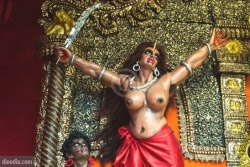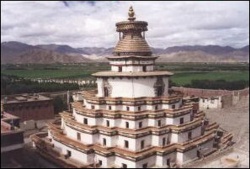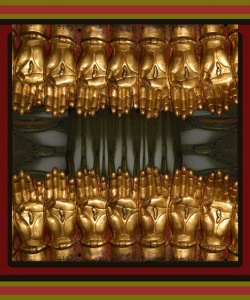Tibetan Culture
Tibetan Opera
Tibetan opera performance begins with a prologue consisting of goddesses, elders (gyalu) and hunters (wenpa). Traditional Tibetan opera is known as a-chi lhamo (sister goddesses) since the main roles are goddesses or dakinis. Tibetan opera is rooted in the snow land of the Tibetan plateau. Influenced by religion and other Tibetan cultural elements, the operas have strong ethnic and religious overtones and are very popular. Some good traditional Tibetan operas are still in the repertoire. For instance, Princess Wencheng tells the story of the "seven tests to win the bride,"namely the tests of wisdom imposed by the Tang emperor on the Tubo envoy before agreeing to give the princess in marriage to Songtsen Gampo. This Tibetan opera is a vivid depiction of the history of the Tang-Tubo marriage alliance.
Tibetan Tangka
Tibetan Tangka is a unique Tibetan art form, a highly colored painting on silk, cloth or paper, and surrounded by a colorful decorative border of satin. Its themes are religious figures, religious events or Buddhist doctrine. The composition of the Tangka is ingenious and the painting technique is superb, giving it a strong artistic appeal and religious mystique. It’s usually vertically long, with no certain size. The picture is first drawn on a white cloth, and then it will be stretched with a frame, pasted, polished, sketched with threads and painted. After that, the picture will be edged with colorful satins and mounted on a cotton or silken cloth. In the front, two pieces of yellow silk bands and two ribbons will be added to be curtain and streamers. Hard wood scrolls are then added to the top and low ends of the picture. A Tangka is finished.
Tibetan Mural
The mural of Tibet attaches great importance to the purity and order of colors. The yellow, blue, red and green are the most often used colors in these paintings. Each of them has abstruse meanings strong decorative effect and local flavor. In history, the mural covered a wide range of gods, construction process of a monastery, history and legend depicting Tibetan changes with inland areas, production scenes such as hunting and farming, folk customs, entertainment, and portraits of revered lamas, Living Buddhas and emperors of the Ming and Qing dynasties. So the mural of Tibet not only reflects a mysterious supernatural state, but also records the daily lives of common people.
Tibetan Sculpture
The Tibetan sculptures are divided into stone, wood, mud and metal sculptures.The early stone sculptures were from the Tubo Kingdom. For example, the stone lions in front of the Tombs of Tibetan Kings in Qonggyai, the stone lions and white marble statues in the Samye Monastery. Tsa-tsa refers to a kind of demoulding clay sculpture, usually in small size, but every exquisite. The wood and metal sculptures center in temples, with the most classical ones found in the Potala Palace and the Johkang Monastery. The metal sculptures, with complicated process, often surprise visitors. Some masks in Tibetan art also belong to sculpture, such as the wood, bronze and clay masks. The butter figurines are made from butter mixed with mineral colors, unique in the world plastic arts. The butter is made into the shapes of god, Buddha, common people, flower, grass, tree bird, beast, pavilions and buildings. As butter doesn’t endure heat, it is mainly made in winter. On the 15th day of the 1st month according to Tibetan calendar, numerous butter works will meet the public in front of the Johkang Monastery. It is the largest and most influential Butter Lantern Festival in Tibet.
Tibetan Dress
The main features of Tibetan dress are long sleeves, wide waistbands and big robes. Farmers’ robes are usually made of coarse tweed. Both men and women’s gowns are loosely tied at the waist. Tibetan gowns are made extra-long, so when dressing, the gown is lifted and tied around the waist with a waist sash. This is done to adjust the gown’s length so that the hem touches the feet. Tibetan herdsmen dress in a distinctive style, predominantly in gowns made of sheepskin. The men’s garments are edged along the lapel, sleeves and hem with black velvet, corduroy or woven wool bands, while women wear hand-spun multi-color striped aprons over their gowns. Tibetan adornments aim for an air of composure and are gorgeous and splendid, an expression of the wearer’s wealth. Gold, silver, ivory, coral, jade and turquoise are the most popular materials for fashioning jewelry which is used to adorn each and every part of the body – hair, ears, necks, waists, and fingers, chests.
Tibetan Medicine
Tibetan medicine, developed by Tibetan ethnic group mainly, is an important part of traditional Chinese medicine. It boasts a long history, unique characteristics and has remarkable effect on difficult and complicated cases of illness.In Tibetan medicine, it is believed that "long", "chiba", and "peigen"are three essential elements of human body, each having its physiological functions. Normally, the three elements keep a coordinated and balanced relationship. If sometimes one is stronger or weaker than the others, illness occurs. Tibetan medicine had a profound understanding of human physiological anatomy long time ago and realized that human embryo is developed from father’s sperm and mother’s blood. It pointed out that an embryo would go through three stages before full maturity: fish (aquatic animal), tortoise (reptile) and pig (mammal). This accurately describes the evolution history of a higher animal and contributes a lot to both the Chinese and world medicine. According to Tibetan medicine, any illness has internal and external causes. The internal reason is the imbalance between "long","chiba" and "peigen", while external causes might be climate change, improper living or food customs and injuries. In clinical practices, Tibetan medicines are categorized into long, chiba, peigen, medical, surgery, gynecology, pediatrics and facial departments.
Tibetan Language
Although some Tibetan people involved in the tourist industry are now conversant in several languages including English, most Tibetans speak only their native language with perhaps a smattering of Mandarin. Even a few words of Tibetan are not only greeted enthusiastically but are well high essential if you’re heading off the beaten track of going trekking.Tibetan language belongs to the small Tibetan-Burmese group of languages and has no similarity at all to Mandarin or Hindi. Tibetan script was developed in the seventy century and has thirty consonants and five vowels which are placed either beside, above or below other letters when written down. There are obvious inaccuracies when trying to render this into the Roman alphabet and the situation is further complicated by the many dialects across the region; the Lhasa dialect is used in the vocabulary below. Word order is back-to-front relative to English, and verbs are placed at the ends of sentences-"this noodle soup is delicious"becomes "tukpa dee shimbo do", literally "noodle soup this delicious is". The only sound you are likely to have trouble with is ng at the beginning of words-it is pronounced as in sang.
Basic phrases:
Hello / tashi delay
Goodbye, to someneone staying / kalay shu
Goodbye, to someone going / kalay pay
Thank you / tuk too jay
Sorry / gonda
Please--coochee
How are you? / kusu debo yinbay?
Im ... / nga...
Fine / debo yin
Cold / kya
Hungry / throko-doe
Thirsty / ka gom
King Gesar
The epic King Gesar has circulated among Tibetans for over 1,000 years. It came into being around the first century and gradually developed until the 10th and 11th centuries, in the transition between the disintegration of primitive society and the formation of the slave system. Its main subject matter concerns the wars between different tribes and ethnic groups. In areas of Tibetan population in Sichuan, particularly around Dege, people believe that King Gesar was a real historical figure born in what is now the village of Ashul, in Dege County of Garze. A giant bronze statue of Gesar, 3.8 tons in weight and 10.8 meters high (currently the tallest) has been erected in the Ashul Grassland where it receives great reverence from people. This is one of dozens of Gesar-related historic sites in Dege County; it is here that the epic enjoys the widest circulation and it is home to many ballad singers.King Gesar is a Tibetan heroic epic, passed down orally through the ages. The epic is a collection of ancient tales, legends, sayings, and various folk arts. Thus far, 150 volumes have been collected and compiled; they contain some 1,500,000 lines. Listed by UNESCO as a masterpiece of Oral and Intangible Heritage of Humanity, its 1000-year anniversary was celebrated in 2002-2003 with a range of activities. This had deep significance in China for the protection of traditional Tibetan culture and the promotion of cultural exchange between various ethnic groups in the world.The story of King Gesar was on everyone’s lips during the seventh to ninth centuries, the glory days of the Tubo Kingdom, when national confidence and spirit were at their height.Stories about Gesar have come down through oral transmission and balladeers have played a very important role in handing it down virtually complete today. The Tibet Autonomous Region government has paid great attention to seeking out Gesar balladeers and, over the past few years of scouring the region, has identified over 40 capable balladeers. They all can relate and sing some parts of the epic and so enjoy high fame among the people. They include very elderly artists, young women and even a 12-year-old boy.



